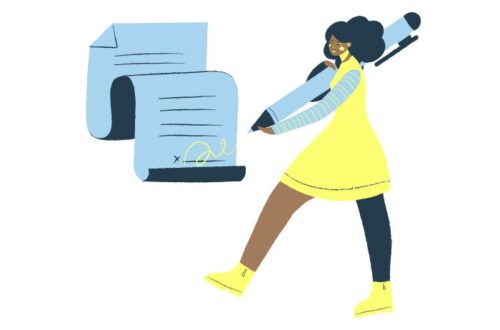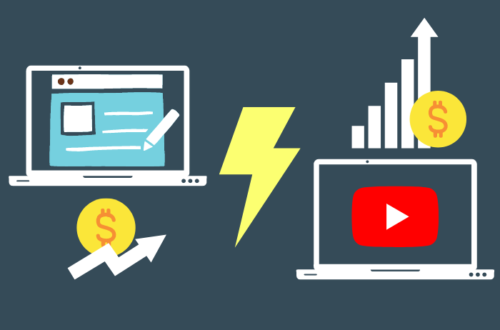
Keep Your Blog Safe From Harm (9 Best Practices)
Keeping your blog safe from harm and hackers is important to prevent you from losing everything: all your posts and files, your saved customizations and changes, your traffic, your hard work, and ultimately your source of income.
This page contains affiliate links. If you purchase through our links, we get a commission at no cost to you. Read the full disclosure here.
Taking care that damage doesn’t happen to your WordPress blog along with making sure your privacy is protected should be at the top of your blogging schedule priorities, not the bottom line — which is probably the case.
You might not know it, but WordPress.org is a completely customizable open-source Content Management System (CMS). So it’s up to you to set up certain functions that will protect your blog from harm, as well as your privacy, since they’re not automatically enabled.
In addition, due to the huge popularity of WordPress (powering about 40% of websites), WordPress websites along with their respective owners are constant targets of hacking attempts, malware injection, data leakage, and other cybercrime.
In this article, you’ll find the basic security procedures for a WordPress website, the simplest to put into practice, and the complete must-have!
While this isn’t fun like talking about passive income, it will protect you from losing everything in the future, including your much-loved passive income. So make sure to bookmark this powerful guide, or save this helpful PIN, to put all this information into practice as soon as possible.
See also: How secure are WordPress websites for e-commerce? Pros and cons
Table of content
- Are There Any Dangers to Blogging?
- Can Someone Hack My Blog?
- 9 Best Practices to Keep your Blog Safe
- 1. Choose a good web hosting service
- 2. Install a reliable WordPress Security Plugin
- 3. Backup your website regularly
- 4. Install an SSL Certificate
- 5. Use STRONG passwords
- 6. Don’t keep unnecessary plugins installed
- 7. Delete all inactive plugins and themes
- 8. Always update your plugins manually
- 9. Choose a reliable theme
- FAQ
Are There Any Dangers to Blogging?
Yes, there are dangers in blogging that many bloggers are not aware of. Self-hosted blogs like WordPress blogs have many security holes in their installations. Additionally, Plugins and Themes may also have gaps in their code or incompatibilities with your current version of WordPress that can cause damage to your blog.
It is common for bloggers to focus their attention on creating blog posts that convert and monetize. As a result, keeping their blogs safe from harm takes a backseat. Frequently, they never consider damage prevention until it’s too late.
Can Someone Hack My Blog?
Yes, open ports in the coding of your WordPress blog, flaws in Plugins and Theme codes, and lack of precaution with login credentials, among others, can allow someone to hack your blog.
If a hacker breaks into your blog when you’re just starting out, you might not have much of a loss. On the other hand, if you get hacked when you are already making money from your blog, the pain you will feel in your pocket will be hard to deal with.
In addition, you can lose all your content and even access to your blog.
Check out the 9 best practices below to easily keep your website or blog safe from harm and hackers.
Helpful Guide Including 9 Hacks That Will Keep Your WordPress Blog Safe From Harm and Hackers

1. Choose A Good Web Hosting Service — That’s The First Step to Keep your Blog Safe from Harm
Everything starts where you host your WordPress blog. A trustworthy web hosting service will take proper steps to keep your website secure.
A good web hosting service for WordPress should, at the very least:
- Be fast
- Provide 24/7 customer support
- Keep your privacy protected
- Provide a secure connection
- Keep your website backed up
- Keep WordPress up to date
I always recommend DreamHost’s Shared Unlimited plan for starters. DreamHost is an extremely affordable and reliable web hosting service, for both beginners and those who have been on the blogging journey for some time.
You can click here to get started with DreamHost’s Shared Unlimited plan. Make good use of this offer that will give you a year of fast and reliable hosting plus free professional email for just $35.40 (no hidden fees!).
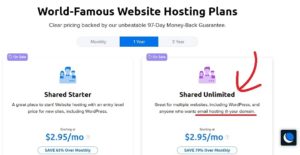
Besides, DreamHost is officially recommended by WordPress itself!
2. Install A Reliable WordPress Security Plugin to Keep your Blog Safe from Harm
A WordPress security plugin stops hack and malware injection attempts, protects your site from brute force attacks, periodically scans your website, informs you every time a user logs in and from which IP, and sends you periodic emails letting you know how secure your website is. Also, it allows you to configure custom security settings and even cleans your website quickly if it has been hacked.
If you’re the kind of person who doesn’t worry about protecting your website because “it will never happen to you”, think about it: 30,000 websites are hacked every single day on average. Also, hackers prey on small to medium-sized businesses, because they know most of them don’t have solid security measures in place.
If you want to deny access to your admin panel from devices you don’t know and stay protected from brute force attacks, automated attacks, and malware injection, then you can count on Solid Security / SolidWP (former iThemes Security) to protect your website, which is the most complete WordPress security service out there.
Solid Security / SolidWP has 1+ Million (!) active installations and one of the most attractive prices on the market. It seems truly amazing to me that it’s possible to have a top-quality WordPress security system for such an affordable price. Some other security services are just insanely expensive!
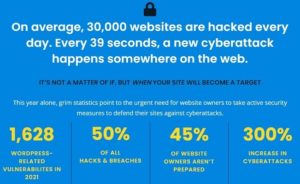
Also, Solid Security blocks bots that keep trying to figure out your password (bots can try MILLIONS of password combinations per second!) and assures you that if a hacker breaks into your site, they will identify the attack immediately and take the necessary measures to limit the damage they can do.
Another reason why I recommend Solid Security is that this plugin makes it easy to implement other security measures that would otherwise require some coding knowledge. And if coding isn’t your thing, with Solid Security you only have to press a button, literally.
If you want to know more about Solid Security, you can visit the Solid Security / SolidWP homepage here.
3. Backup your Website Regularly
Backing up your site regularly is one of the most important steps to keep your blog safe from harm, as malware injections, server crashes, dodgy updates, or simple user errors can ruin your WordPress site.
If something goes wrong, you can restore backups directly from your WordPress Dashboard, so you don’t lose all your hard work!
A good web hosting service will allow you to make backups from your cPanel and download them to your local PC.
Even the most basic DreamHost plan offers Daily Backups, a function often charged separately or just included in the more expensive packages in most other hosting services.
However, it’s also good to back up your website directly from your WordPress Dashboard, which is the easiest and fastest way. For that, you need a backup plugin.
I’ve changed backup plugins many times in my 7+ years of blogging, and it was so annoying!
Some backup plugins NEVER complete the backup or take hours to complete, while others have compatibility issues with many web hosting services. Additionally, some services just aren’t reliable – that is, when you need to restore a backup, you realize that the backup didn’t store all your files. Believe me, this is tragic.
When choosing a backup service to protect your blog from harm, you have to make sure that the service covers these 4 elements:
1. Perform FULL backups of your WordPress website, which includes your database and ALL your WP files
2. Allow you to set backups to be scheduled and performed automatically
3. Allow you to send and store your backups off-site, in a safe place you choose, such as your local PC or some cloud service
4. It has fast and easy website restoration from a backup
Not all backup services have all these elements. Therefore you will need to install several plugins for each element, which is cumbersome and insecure. When your site has a problem and you need to restore a backup, this needs to be done as quickly as possible. Furthermore, as you will see in item #6 of this article, having too many plugins installed on your site is one of the worst mistakes you can make as a blogger.
For all that has been discussed here, the most complete backup service I recommend is Solid Backups / SolidWP (former BackupBuddy), which has been protecting over 1 million WordPress sites since 2010.
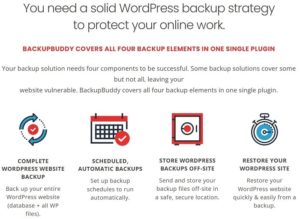
In addition to being a 4-in-1 plugin, bringing together all the crucial elements that a backup plugin must have to be reliable, Solid Backups / SolidWP also offers you 1GB of free storage space, below-average prices, and annual subscriptions, which is a lot handier (and cheaper!) than monthly payments.
Be sure to check out Solid Backups to ensure that no matter what happens to your site, from hacks to a complete website crash, you won’t lose your hard work and will be able to restore your website just the way it was before within minutes!
How to backup your website (including the current contents of all your FTP users, mailboxes, and MySQL databases) from your DreamHost Account:
- From your DreamHost account dashboard, select Billing & Account > BackUp Your Account.
- Select Back Me Up and wait till the process is finished.
- Download your backup archives to your local PC and store them in your preferred cloud storage services or even in a pen drive.
How to backup your website using the Solid Backups / SolidWP plugin for the first time:
- First, log into your WordPress site as an Administrator, install the Solid Backups / SolidWP plugin like any other WordPress plugin, and activate it.
- Enter your email for notifications and create a password to restore and migrate backups.
- Choose a remote location to send and store your backups.
- Create a schedule for automatic backups.
- Save settings. Then an automatic backup will begin. Once finished, you can choose to download the backup or send it to your desired storage space.
4. Be SSL Certificated
SSL is a protocol that stands for Secure Sockets Layer. The SSL keeps the internet connection secure and safeguarded, and prevents criminals from reading or modifying any information transferred or any sensitive data (such as addresses and credit card details) that is being sent between two systems.
So that there is no leakage of any sensitive information that is transferred between the web server and the web browser, an SSL certificate must be installed to establish an encrypted link between networked computers.
SSL is the standard technology that informs Google that your website is reliable. Without an SSL, Google will notify anyone who visits your site that the connection is not secure.
Nowadays, most web hosting platforms offer free Let’s Encrypt SSL installed. Sometimes the certificate can come pre-installed and you might not know that you have to conclude the installation yourself (usually just one click!). So check with your web hosting service if they don’t have the certificate available, as this is the easiest way to have the SSL certificate installed on your site.
5. Use STRONG Passwords and NEVER REUSE The Same Password
You’ve probably heard of the widespread data leakage that is happening more and more often, which includes, of course, login credentials leakage, right?
My antivirus provider now and then sends me emails notifying me that there’s been another leak, so I should consider changing all my passwords. Again.
It is more important than ever that the media and the public understand what is happening in the world of cybersecurity today and what has been happening over the last two decades. The data breach pandemic is here to stay. Data breaches, including password breaches, are destined to become more common and more grandiose in scale. This will only become more common as people make more and more single-use accounts with organizations that don’t implement strong security. — Forbes
As you see, this data leakage pandemic is particularly alarming if you use the very same password, probably a short and weak one, on more than one service you use — let alone if you use the same password on ALL the services you use! (Please, do not do that!)
Using strong passwords, and never repeating them is one of the simplest, but most powerful, ways to protect your digital properties.
Use always a mix of special symbols, upper and lower case letters, and numbers in your passwords. Also, never use commemorative dates (such as birthdays, the birth of children, marriage, etc) and pet names as passwords. Preferably, avoid the use of actual words and phrases as well.
This recommendation is for your login credentials on your website, on your hosting service, and on your professional and personal emails.
But, in fact, you should implement this practice in absolutely every service you are registered for. Even the banalest ones like streaming services.
6. Don’t Keep Unnecessary Plugins Installed On your Website
Plugins are amazing because they allow you to add almost any function to your WordPress website. It’s exciting to think about all the new features and customizations your blog can have just by installing a few new plugins.
But hold on for a while! None of this means you should install one plugin after another, without any breaks.
The more plugins you have installed on your WordPress website, the more susceptible your website is to malicious attacks from hackers because plugins still are their primary target when it comes to hacking WordPress users.
Furthermore, plugins can slow down your blog, which is bad for SEO as it harms the user experience.
So, as a forethought, don’t install too many plugins and only use those that are indeed necessary.
Tip #1: You may be wondering how many plugins are too many plugins. Well, typically, to have a visually pleasing blog, easy to navigate and protected, you will need around 20, even 30, plugins. That’s a good rule of thumb to follow, so try not to exceed this number.
Tip #2: Choose a WordPress Theme that already has most of the customization features you are interested in, so you don’t have to install a lot of additional plugins just to perform small functions.
7. Delete All Inactive Plugins and Themes
Sometimes you keep plugins and themes installed but inactive because you think they might be helpful in the future. Well, if they had any real benefit at the moment, they wouldn’t be inactive, right?
Besides, you can always reinstall any plugin or theme in the future, if you realize later that you actually need those functions.
The truth is that those plugins and themes you keep inactive will be the first targets of hackers trying to break into your WordPress website. If you want your blog to be protected from harm, you need to make it harder for hackers — not make it easier for them.
So make sure which plugins and themes you really need and get rid of those that are useless.
8. Always Update your Plugins MANUALLY to Keep your Blog Safe from Harm Caused by Update Incompatibility
Most plugins you use on WordPress will keep sending you notifications on your Dashboard telling you to configure the automatic update. This is annoying, but even if you have the impulse to enable auto-update just to get rid of notifications, or because you think it’s safer, just don’t do it!
The updated version of a plugin can break your website!
This usually doesn’t happen, but it’s not such a rare phenomenon either. It happened to my first blog and was catastrophic.
If there’s an incompatibility issue with the updated version of a plugin and your current WordPress version, and that happens after an automatic update, your site will be down until you find out what happened and do something about it. And if you’re not in the habit of logging into your website or checking your email every day, who knows how many days your website will be offline without you even knowing about it!
You surely DON’T want that to happen.
You DON’T want to miss pageviews from people interested in your content. People who clicked on one of your links but didn’t find an active site and went looking for similar content on someone else’s website.
Also, if multiple plugins were automatically updated at the same time, it would be even harder for you to know which of them caused the problem.
So always update your plugins manually. And always back up your website BEFORE doing ANY updates. It’s annoying, I know, but if something goes wrong, you’ll know immediately and be able to restore your website within minutes by restoring your last backup.
This practice is a little more laborious and kind of boring to be carried out, but it is certainly an important way to keep your WordPress site safe from harm.
How to disable plugin auto-updates:
- From the Dashboard, select Plugins > Installed Plugins.
- Select all plugins by filling in the checkboxes.
- Navigate the left drop-down menu Bulk actions > Disable Auto-updates > Apply.
PRO TIP: Never take too long to update your Plugins and Themes when a new version becomes available. That’s a rule of thumb to keep your blog safe from harm!
You should update your plugins and themes as soon as possible, as updates often fix bugs that present risks to your website and privacy.
By keeping the outdated versions, you keep your blog at the mercy of security flaws not yet fixed.
9. Choose a Reliable Theme
If you choose a theme that is poorly coded, it will expose your website to programming flaws.
On the other hand, if you commit the disastrous mistake of illegally downloading the pro version of a premium theme, it would be almost like begging to be hacked, I promise you.
Those few buckets you think you’re saving will cost you dearly when you realize your site has been hacked.
Illegal downloads will undoubtedly come with holes in the code, which will make it very easy for a hacker to break into your site. Also, you won’t have access to your theme premium support, of course, since you won’t have a valid premium subscription key.
The WordPress Themes I always recommend are Ashe PRO by WP Royal and Divi Theme by Elegant Themes. Both are professional, easy to customize, SEO-optimized, and very affordable to purchase. Also, they offer Lifetime Theme Updates, Security Updates, Premium Support, and 30 Days Money Back Guarantee.
This way you will have a premium subscription valid for the rest of your life, to install on any website you may have, without worrying about exposing your WordPress blog to risks.
Keep Your Blog Safe From Harm and Hackers FAQ
How Can You Stay Safe On a Blog
Keeping your blog safe from harm and hackers is easier than you might think, although it may be a little tiresome. It is of paramount importance, however, to put the task of securing your blog ahead of all your other blogging tasks.
There’s no point in making an effort to grow your blog if you’re still at the mercy of losing everything at any given moment.
Is It Safe to Have a Blog?
It is safe to have a blog when you take all steps to keep your blog and your privacy safe. For bloggers, investing in security tools for their blogs is indispensable. But it’s also crucial to avoid revealing too much personal information online.
Remember that the bigger your blog gets, the more strangers will be looking at you. And you never know which bad intentions some of these people might have. So remember that security measures for your blog and your privacy are never too much!
Can You Keep a Blog Private?
You can easily keep your WordPress blog private by logging into your blog with your Admin account and enabling this option in “General Settings”.
But keep in mind that this will prevent your blog and blog posts from showing up in search engines. That is, while many bloggers use an SEO strategy to grow their blogs without depending on social media, you cannot do the same with a private blog.
To get the people you want to find your blog, you will have to redirect them through social networks or paid Ads.
In the long run, this can become impractical to monetize your content.
Keep Your Blog Safe From Harm — Final Thoughts
While taking care of your blog’s security isn’t fun like other parts of blogging, it’s the only way to keep your blog safe from harm. Not to mention being fully protected against constant hacker attacks.
Make a small break in your blogging schedule to apply all these basic security measures to your website as soon as possible. Even if you take these steps little by little!
Read next:
- Why is the WHOIS database public (and how to hide your personal information)
- The ultimate guide to domain privacy: why do you need WHOIS privacy?
- Improve WordPress Security with 9 Advanced Tips
- 5 Reliable Ways To Protect Your Privacy As a Blogger
Share on Pinterest!
Originally posted on November 13, 2021. Last updated on January 30, 2025.




